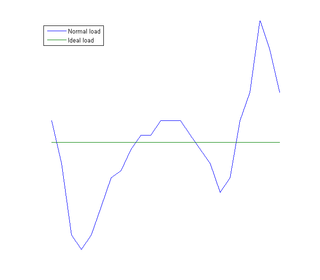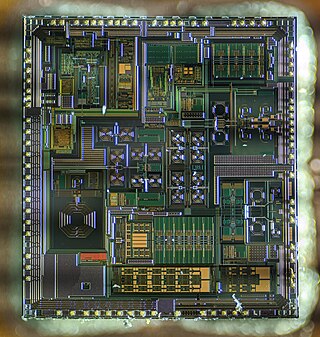
A wireless network is a computer network that uses wireless data connections between network nodes. Wireless networking allows homes, telecommunications networks and business installations to avoid the costly process of introducing cables into a building, or as a connection between various equipment locations. Admin telecommunications networks are generally implemented and administered using radio communication. This implementation takes place at the physical level (layer) of the OSI model network structure.

Wireless communication is the transfer of information (telecommunication) between two or more points without the use of an electrical conductor, optical fiber or other continuous guided medium for the transfer. The most common wireless technologies use radio waves. With radio waves, intended distances can be short, such as a few meters for Bluetooth, or as far as millions of kilometers for deep-space radio communications. It encompasses various types of fixed, mobile, and portable applications, including two-way radios, cellular telephones, personal digital assistants (PDAs), and wireless networking. Other examples of applications of radio wireless technology include GPS units, garage door openers, wireless computer mouse, keyboards and headsets, headphones, radio receivers, satellite television, broadcast television and cordless telephones. Somewhat less common methods of achieving wireless communications involve other electromagnetic phenomena, such as light and magnetic or electric fields, or the use of sound.

Power-line communication (PLC) is the carrying of data on a conductor that is also used simultaneously for AC electric power transmission or electric power distribution to consumers. The line that does so is known as a power-line carrier.

HomeRF was a wireless networking specification for home devices. It was developed in 1998 by the Home Radio Frequency Working Group, a consortium of mobile wireless companies that included Proxim Wireless, Intel, Siemens AG, Motorola, Philips and more than 100 other companies.

A smart meter is an electronic device that records information—such as consumption of electric energy, voltage levels, current, and power factor—and communicates the information to the consumer and electricity suppliers. Such an advanced metering infrastructure (AMI) differs from automatic meter reading (AMR) in that it enables two-way communication between the meter and the supplier.

Utility sub-metering is a system that allows a landlord, property management firm, condominium association, homeowners association, or other multi-tenant property to bill tenants for individual measured utility usage. The approach makes use of individual water meters, gas meters, or electricity meters.

Load management, also known as demand-side management (DSM), is the process of balancing the supply of electricity on the network with the electrical load by adjusting or controlling the load rather than the power station output. This can be achieved by direct intervention of the utility in real time, by the use of frequency sensitive relays triggering the circuit breakers, by time clocks, or by using special tariffs to influence consumer behavior. Load management allows utilities to reduce demand for electricity during peak usage times, which can, in turn, reduce costs by eliminating the need for peaking power plants. In addition, some peaking power plants can take more than an hour to bring on-line which makes load management even more critical should a plant go off-line unexpectedly for example. Load management can also help reduce harmful emissions, since peaking plants or backup generators are often dirtier and less efficient than base load power plants. New load-management technologies are constantly under development — both by private industry and public entities.

The smart grid is an enhancement of the 20th century electrical grid, using two-way communications and distributed so-called intelligent devices. Two-way flows of electricity and information could improve the delivery network. Research is mainly focused on three systems of a smart grid – the infrastructure system, the management system, and the protection system. Electronic power conditioning and control of the production and distribution of electricity are important aspects of the smart grid.

Radio is the technology of communicating using radio waves. Radio waves are electromagnetic waves of frequency between 3 hertz (Hz) and 300 gigahertz (GHz). They are generated by an electronic device called a transmitter connected to an antenna which radiates oscillating electrical energy, often characterized as a wave. They can be received by other antennas connected to a radio receiver, this is the fundamental principle of radio communication. In addition to communication, radio is used for radar, radio navigation, remote control, remote sensing, and other applications.
LDMOS is a planar double-diffused MOSFET used in amplifiers, including microwave power amplifiers, RF power amplifiers and audio power amplifiers. These transistors are often fabricated on p/p+ silicon epitaxial layers. The fabrication of LDMOS devices mostly involves various ion-implantation and subsequent annealing cycles. As an example, the drift region of this power MOSFET is fabricated using up to three ion implantation sequences in order to achieve the appropriate doping profile needed to withstand high electric fields.
Meter data management (MDM) refers to software that performs long-term data storage and management for the vast quantities of data delivered by smart metering systems. This data consists primarily of usage data and events that are imported from the head-end servers managing the data collection in advanced metering infrastructure (AMI) or automatic meter reading (AMR) systems. MDM is a component in the smart grid infrastructure promoted by utility companies. This may also incorporate meter data analytics, the analysis of data emitted by electric smart meters that record consumption of electric energy.
Tropos Networks is a wireless mesh networking company that provides hardware, embedded software and network management application software for building large scale wireless networks. These networks are used by utilities, municipalities, public safety agencies, mines and others that need to communicate with fixed and mobile assets, as well as mobile workers, in the field. The company was founded in 2000 by Narasimha Chari, Devabhaktuni "Sri" Srikrishna, Christian Dubiel and Jonathan Goldenstein. It is headquartered in Sunnyvale, California. In June 2012, it was acquired by ABB Power Grids Group, now Hitachi Energy.
The OpenHAN standards for home networks was promoted by groups such as openAMI and UtilityAMI. Both efforts aim to standardize powerline networking interoperation from a utility point of view and ensure reliable communications co-extant with AC power outlets. Both utilities and vendors of home control have promoted such standards aggressively. The openHAN label usually denotes standards favored by the utilities, not other service providers. It should be distinguished from the openADR standards that were promoted to ensure open access to customer electricity use data by all service providers.

An RF module is a (usually) small electronic device used to transmit and/or receive radio signals between two devices. In an embedded system it is often desirable to communicate with another device wirelessly. This wireless communication may be accomplished through optical communication or through radio-frequency (RF) communication. For many applications, the medium of choice is RF since it does not require line of sight. RF communications incorporate a transmitter and a receiver. They are of various types and ranges. Some can transmit up to 500 feet. RF modules are typically fabricated using RF CMOS technology.
Mueller Systems is a manufacturer and distributor of advanced metering infrastructure (AMI) and automatic meter reading (AMR) technology, as well as residential, commercial and fire-line meters and related products. It is a subsidiary of Mueller Water Products. Founded as Hawes and Hersey Company in 1859, Mueller Systems is the oldest manufacturer of water meters in the United States.
Verdigris Technologies (Verdigris) is an artificial intelligence technology start-up founded in 2011 by Mark Chung, Thomas Chung and Jonathan Chu. The company is headquartered in the NASA Ames Research Center located in Silicon Valley in California.
A Distribution Transformer Monitor (DTM) is a specialized hardware device that collects and measures information relative to electricity passing into and through a distribution transformer. The DTM is typically retrofitted onto pole top and pad mount transformers. A pole top or pad mount transformer commonly powers anywhere from 5-8 homes in the US and is the last voltage transition in stepping down voltage before it gets to the home or business. The conventional placement of Distributed Temperature Monitoring (DTM) devices is typically observed at the terminals of transformers. However, there are instances where these devices are directly affixed to the secondary power lines.
In Iran, like many other developed countries, Smart Grid implementation is regarded as a unique way for encountering many serious environmental and economic challenges that mankind is faced today. FAHAM is the National Smart Metering Program in Iran. The functional, technical, security, economic, and general requirements of this project was published as a document after a longtime workgroup of various stakeholders including representative of grid operators, meter manufactures, communication providers, business layer software providers, domestic and international consultants. The procedure of producing this document was base on EPRI Methodology. In these technical documents all of the business and functional use cases, the conceptual architecture, mandatory international standards for electric, water and gas metering systems(for all types of consumers), telecommunication requirements, system interfaces and security mandates are defined. The ministry of energy decided to perform a pilot project called FAHAM-phase1, in order to experiment the execution and technical challenges for implementing Smart Metering for all of the consumers.
Wize technology is a low-power wide-area network technology using the 169 MHz radio frequency. It was created by the Wize Alliance in 2017. Derived from the European Standard Wireless M-Bus, it has mainly been used by utility companies for smart metering infrastructures (AMI) for gas, water and electricity but is equally open to other applications in industry and 'Smart City' spaces.

RF CMOS is a metal–oxide–semiconductor (MOS) integrated circuit (IC) technology that integrates radio-frequency (RF), analog and digital electronics on a mixed-signal CMOS RF circuit chip. It is widely used in modern wireless telecommunications, such as cellular networks, Bluetooth, Wi-Fi, GPS receivers, broadcasting, vehicular communication systems, and the radio transceivers in all modern mobile phones and wireless networking devices. RF CMOS technology was pioneered by Pakistani engineer Asad Ali Abidi at UCLA during the late 1980s to early 1990s, and helped bring about the wireless revolution with the introduction of digital signal processing in wireless communications. The development and design of RF CMOS devices was enabled by van der Ziel's FET RF noise model, which was published in the early 1960s and remained largely forgotten until the 1990s.













